Research on Low-Carbon Design and Energy Efficiency by Harnessing Indigenous Resources through BIM-Ecotect Analysis in Hot Climates
Abstract
:1. Introduction
2. Literature Review
2.1. Energy Efficiency and Energy Efficient Building
2.2. Energy Efficiency in Architecture
2.3. Green Buildings
Challenges of Green Buildings
- Technical difficulties during the construction process.
- High-green appliance design and energy + material cost savings [29].
- Lack of awareness and knowledge about green buildings [30]
- Lack of integrated building regulations and bye-laws within the green framework.
- Lack of motivated demand from customers and insufficient policy implementation efforts [31].
2.4. Evaluation of Building Materials for Greenness
2.5. Common Materials Used in Green Buildings
3. Design and Methodology
3.1. Materials and Methods
3.2. The Analysis Tool of Choice Is Autodesk Ecotect
4. Case Study
4.1. Geographical Location and Climatic Zone
4.2. Project Overview
4.3. Site Reading and Analysis
4.4. Design Development Process
4.5. Planning (Ground Floor Plan)
4.5.1. Structure and Methodology
4.5.2. Masonry and Foundation Details
4.5.3. Openings/Doors and Windows
4.5.4. Membrane, Roof, and Air Flow Management
4.5.5. Landscape, Livestock, and Farming
4.6. Energy Efficient Strategies Followed in Design
4.6.1. Primary Materials
4.6.2. System/Techniques Used
4.6.3. Orientation and Rainwater Harvesting
4.7. Three-Dimensional Views and Details
5. Building Energy Evaluation
5.1. Building Energy Analysis through Ecotect
5.2. Hourly Temperature Profile of the Building on the Hottest Day Analyzed
5.3. Hourly Temperature Profile of the Building on the Coldest Day Analyzed
5.4. Hourly Gains Profile of the Building on the Hottest Day Analyzed
5.5. Monthly Heating–Cooling Load of the Building Analyzed
5.6. Hourly Gains Profile of the Building on the Coldest Day Analyzed
6. Results and Discussion
6.1. Analysis of the Hourly Temperature Profile of the Building on the Hottest Day
6.2. Analysis of the Hourly Temperature Profile of the Building on the Coldest Day
6.3. Analysis of the Hourly Gains Profile of the Building on the Hottest Day
6.4. Analysis of the Monthly Heating-Cooling Load of the Building
6.5. Analysis of the Hourly Gains Profile of the Building on the Coldest Day
6.6. Analysis of Building’s Thermal Performance and Energy-Saving Measures
7. Conclusions
- Solar energy: Utilizing photovoltaic (PV) panels to harness solar energy.
- Rainwater harvesting: Implementing channels throughout the roof to collect rainwater.
- Biogas production: Using cattle waste to produce and assemble a biogas plant.
- Integration of indigenous practices and digital strategies: Combining traditional methods with modern digital tools to enable the house to produce its own energy and reduce its carbon footprint.
Author Contributions
Funding
Institutional Review Board Statement
Informed Consent Statement
Data Availability Statement
Conflicts of Interest
References
- Khoza, S. Department of Environmental Affairs Investigating the Potential Use of Public Private Partnerships to Fund Green Building Initiatives: The Case of the Department of Environmental Affairs. Ph.D. Thesis, Stellenbosch University, Stellenbosch, South Africa, 2021. [Google Scholar]
- Videras Rodríguez, M.; Sánchez Cordero, A.; Gómez Melgar, S.; Andújar Márquez, J.M. Impact of global warming in subtropical climate buildings: Future trends and mitigation strategies. Energies 2020, 13, 6188. [Google Scholar] [CrossRef]
- IEA. 2022. Available online: https://www.iea.org/topics/buildings (accessed on 23 January 2023).
- Azam, U.; Farooq, M.; Munir, M.A.; Riaz, F.; Sultan, M.; Rehman, A.U.; Imran, M. Modelling Framework for Reducing Energy Loads to Achieve Net-Zero Energy Building in Semi-Arid Climate: A Case Study. Buildings 2023, 13, 2695. [Google Scholar] [CrossRef]
- Mosly, I. Barriers to the diffusion and adoption of green buildings in Saudi Arabia. J. Mgmt. Sustain. 2015, 5, 104. [Google Scholar] [CrossRef]
- Hoornweg, D.; Pope, K. Population predictions for the world’s largest cities in the 21st century. Environ. Urban. 2017, 29, 195–216. [Google Scholar] [CrossRef]
- Eerikäinen, H.; Sarasoja, A.L. Marketing green buildings–well-structured process or forgotten minor detail? Evidence from Finland. Prop. Manag. 2013, 31, 233–245. [Google Scholar]
- Ying Liu, J.; Pheng Low, S.; He, X. Green practices in the Chinese building industry: Drivers and impediments. J. Technol. Manag. China 2012, 7, 50–63. [Google Scholar] [CrossRef]
- Sun, M.; Xue, Y.; Wang, L. Research on Optimized Design of Rural Housing in Cold Regions Based on Parametrization and Machine Learning. Sustainability 2024, 16, 667. [Google Scholar] [CrossRef]
- Ullah, H.; Zhang, H.; Huang, B.; Gong, Y. BIM-Based Digital Construction Strategies to Evaluate Carbon Emissions in Green Prefabricated Buildings. Buildings 2024, 14, 1689. [Google Scholar] [CrossRef]
- Watson, R.T.; Boudreau, M.C.; Chen, A.; Huber, M. Green IS: Building sustainable business practices. Inf. Syst. 2008, 17, 17. [Google Scholar]
- Deng, Q.; Zhang, S.; Shan, M.; Li, J. Research on Envelope Thermal Performance of Ultra-Low Energy Rural Residential Buildings in China. Sustainability 2023, 15, 6931. [Google Scholar] [CrossRef]
- Tulevech, S.M.; Hage, D.J.; Jorgensen, S.K.; Guensler, C.L.; Himmler, R.; Gheewala, S.H. Life cycle assessment: A multi-scenario case study of a low-energy industrial building in Thailand. Energy Build. 2018, 168, 191–200. [Google Scholar] [CrossRef]
- Jiang, R.; Jin, C.; Wang, H. Research on Energy Conservation and Emission-Reduction Effects of Green Finance: Evidence from China. Sustainability 2024, 16, 3257. [Google Scholar] [CrossRef]
- Irfan, M.; Abas, N.; Saleem, M.S. Thermal performance analysis of net zero energy home for subzero temperature areas. Case Stud. Therm. Eng. 2018, 12, 789–796. [Google Scholar] [CrossRef]
- Xiao, Z.; Li, H.; Jiang, H.; Li, Y.; Alazab, M.; Zhu, Y.; Dustdar, S. Predicting Urban Region Heat via Learning Arrive-Stay-Leave Behaviors of Private Cars. IEEE Trans. Intell. Transp. Syst. 2023, 24, 10843–10856. [Google Scholar] [CrossRef]
- Cai, T.; Dong, M.; Chen, K.; Gong, T. Methods of participating power spot market bidding and settlement for renewable energy systems. Energy Rep. 2022, 8, 7764–7772. [Google Scholar] [CrossRef]
- Jiang, J.; Zhang, L.; Wen, X.; Valipour, E.; Nojavan, S. Risk-based performance of power-to-gas storage technology integrated with energy hub system regarding downside risk constrained approach. Int. J. Hydrogen Energy 2022, 47, 39429–39442. [Google Scholar] [CrossRef]
- Walker, B.; Salt, D. Resilience Practice: Building Capacity to Absorb Disturbance and Maintain Function; Island Press: Washington, DC, USA, 2012. [Google Scholar]
- World Green Building Council. The Business Case for Green Building: A Review of the Costs and Benefits for Developers, Investors and Occupants; WGBC: Washington, DC, USA, 2013. [Google Scholar]
- Kibert, C.J. Sustaination: Green Building Design and Delivery, 3rd ed.; John Wiley and Sons, Inc.: Hoboken, NJ, USA, 2012. [Google Scholar]
- Mahmoudi Saber, E.; Mast, M.; Tham, K.W.; Leibundgut, H. Numerical Modelling of an Indoor Space Conditioned with Low Exergy Cooling Technologies in the Tropics. In Proceedings of the 13th International Conference on Indoor Air Quality and Climate, Hong Kong, 6–12 July 2014; London South Bank University: London, UK, 2014. [Google Scholar]
- Zalejska-Jonsson, A. In the Business of Building Green: The Value of Low-Energy Residential Buildings from Customer and Developer Perspectives. Ph.D. Thesis, KTH Royal Institute of Technology, Stockholm, Sweden, 2013. [Google Scholar]
- Darko, A.; Chan, A.P. Critical analysis of green building research trend in construction journals. Habitat Int. 2016, 57, 53–63. [Google Scholar] [CrossRef]
- Roychowdhury, D.; Murthy, R.V.; Jose, P.D. Facilitating Green Building Adoption—An Optimization Based Decision Support Tool. SSRN Electron. J. 2015, 485. [Google Scholar] [CrossRef]
- Darko, A.; Zhang, C.; Chan, A.P. Drivers for Green buildings: A review of empirical studies. Habitat Int. 2017, 60, 34–49. [Google Scholar] [CrossRef]
- Samari, M.; Godrati, N.; Esmaeilifar, R.; Olfat, P.; Shafiei MW, M. The investigation of the barriers in developing green building in Malaysia. Mod. Appl. Sci. 2013, 7, 1. [Google Scholar] [CrossRef]
- Shafii, F.; Othman, M.Z. Sustainable Building and Construction in South-East Asia. In Proceedings of the Conference on Sustainable Building South-East Asia, Kuala Lumpur, Malaysia, 11–13 April 2005; pp. 11–13. [Google Scholar]
- Kulshreshtha, K.; Bajpai, N.; Tripathi, V.; Sharma, G. Consumer preference for eco-friendly appliances in trade-off: A conjoint analysis approach. Int. J. Prod. Dev. 2019, 23, 212–243. [Google Scholar] [CrossRef]
- Darko, A.; Chan, A.P. Review of barriers to green building adoption. Sustain. Dev. 2017, 25, 167–179. [Google Scholar] [CrossRef]
- Zhang, X.; Shen, L.; Wu, Y. Green strategy for gaining competitive advantage in housing development: A China study. J. Clean. Prod. 2011, 19, 157–167. [Google Scholar] [CrossRef]
- Aghdam, K.A.; Rad, A.F.; Shakeri, H.; Sardroud, J.M. Approaching green buildings using eco-efficient construction materials: A review of the state-of-the-art. J. Constr. Eng. Proj. Manag. 2018, 8, 1–23. [Google Scholar]
- Wei, W.; Ramalho, O.; Mandin, C. Indoor air quality requirements in green building certifications. Build. Environ. 2015, 92, 10–19. [Google Scholar] [CrossRef]
- Hopkins, G.; Goodwin, C. Living Architecture: Green Roofs and Walls; Csiro Publishing: Clayton, VIC, Australia, 2011. [Google Scholar]
- Schröpfer, T. Dense+ Green: Innovative Building Types for Sustainable Urban Architecture; Birkhäuser: Basel, Switzerland, 2015. [Google Scholar]
- United States Green Building Council. Green Building Facts. Available online: http://www.usgbc.org/DisplayPage.aspx?CMSPageID=1718 (accessed on 9 March 2008).
- Spiegel, R.; Meadows, D. Green Building Materials: A Guide to Product Selection and Specification; John Wiley & Sons: Hoboken, NJ, USA, 2010. [Google Scholar]
- Schroeder, H. Sustainable Building with Earth; Springer: Cham, Switzerland, 2016; Volume 582. [Google Scholar]
- Castañeda, K.; Sánchez, O.; Herrera, R.F.; Mejía, G. Highway Planning Trends: A Bibliometric Analysis. Sustainability 2022, 14, 5544. [Google Scholar] [CrossRef]
- Adnan, M.; Hussain, J.; Tahir Shah, M.; Shinwari, Z.K.; Ullah, F.; Bahader, A.; Khan, N.; Latif Khan, A.; Watanabe, T. Proximate and nutrient composition of medicinal plants of humid and sub-humid regions in North-west Pakistan. J. Med. Plants Res. 2010, 4, 339–345. [Google Scholar]
- Wang, Q.K.; Wan, C. Analysis on the influence of building envelope to public buildings’ energy consumption. J. Wuhan Univ. Technol. 2011, 33, 112–115. [Google Scholar]
- Li, H.M.; Zhu, J. Energy audit and energy saving strategy of the existing building in college and university. Build Energy Sav. 2012, 40, 71–73. [Google Scholar]


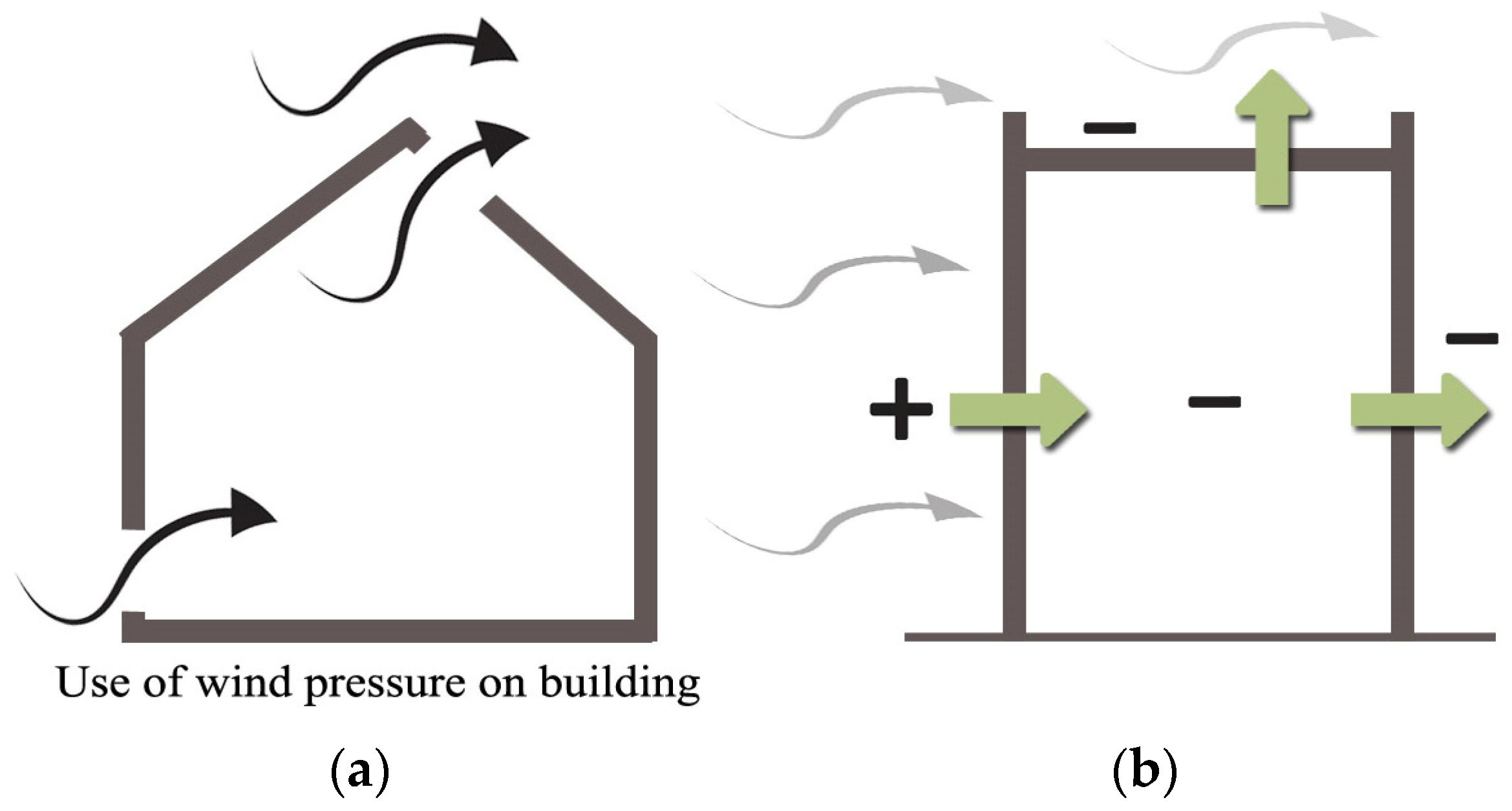







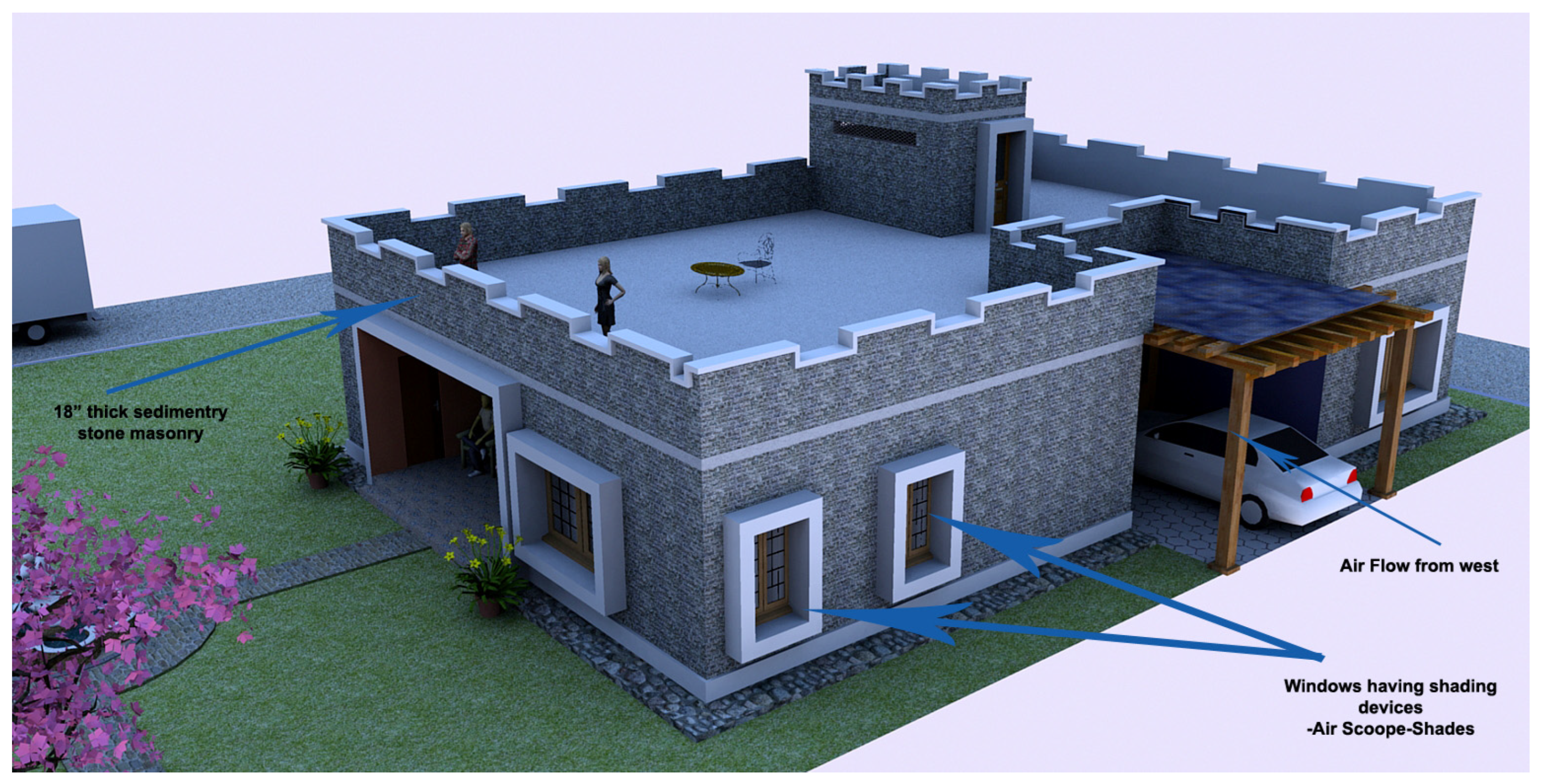
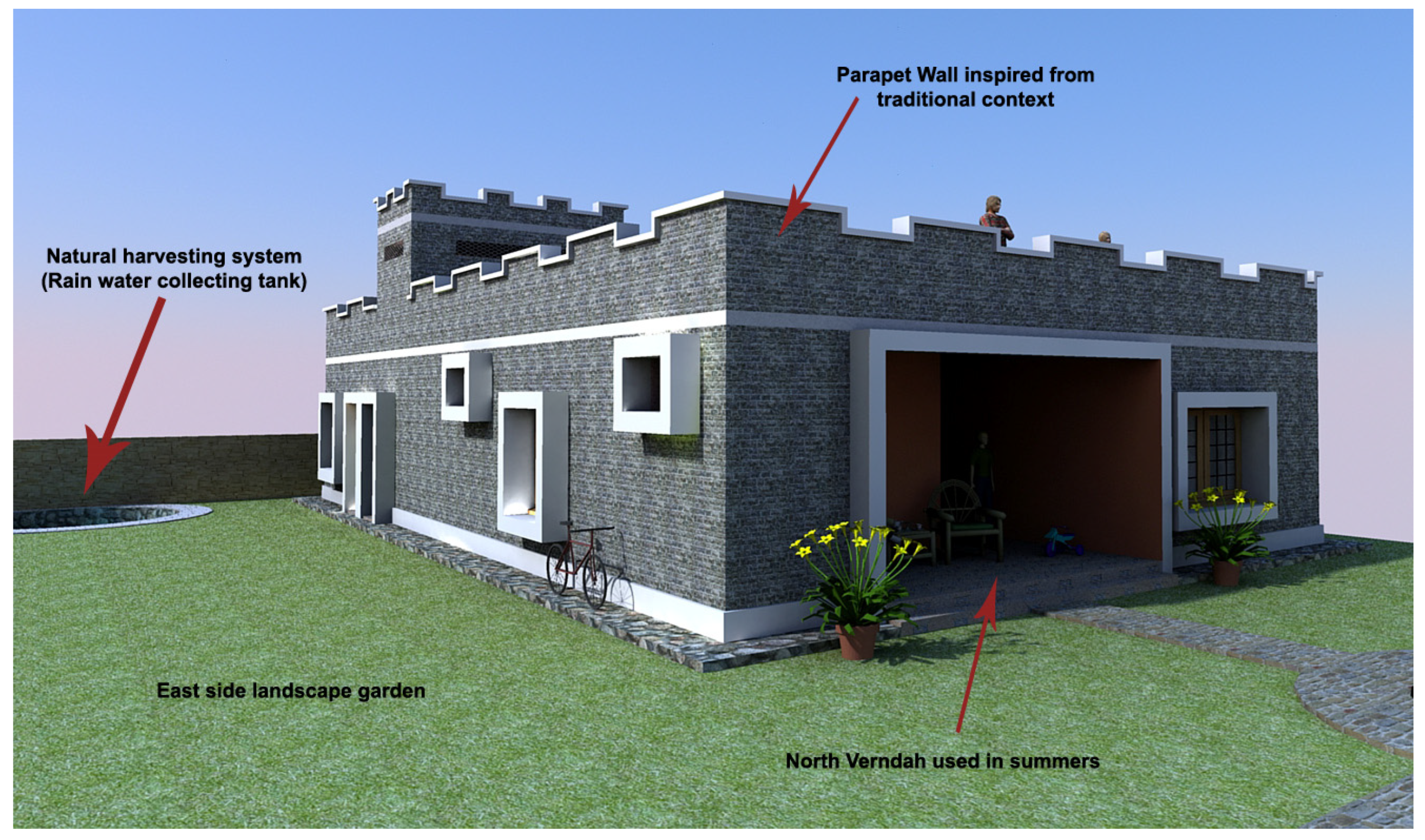
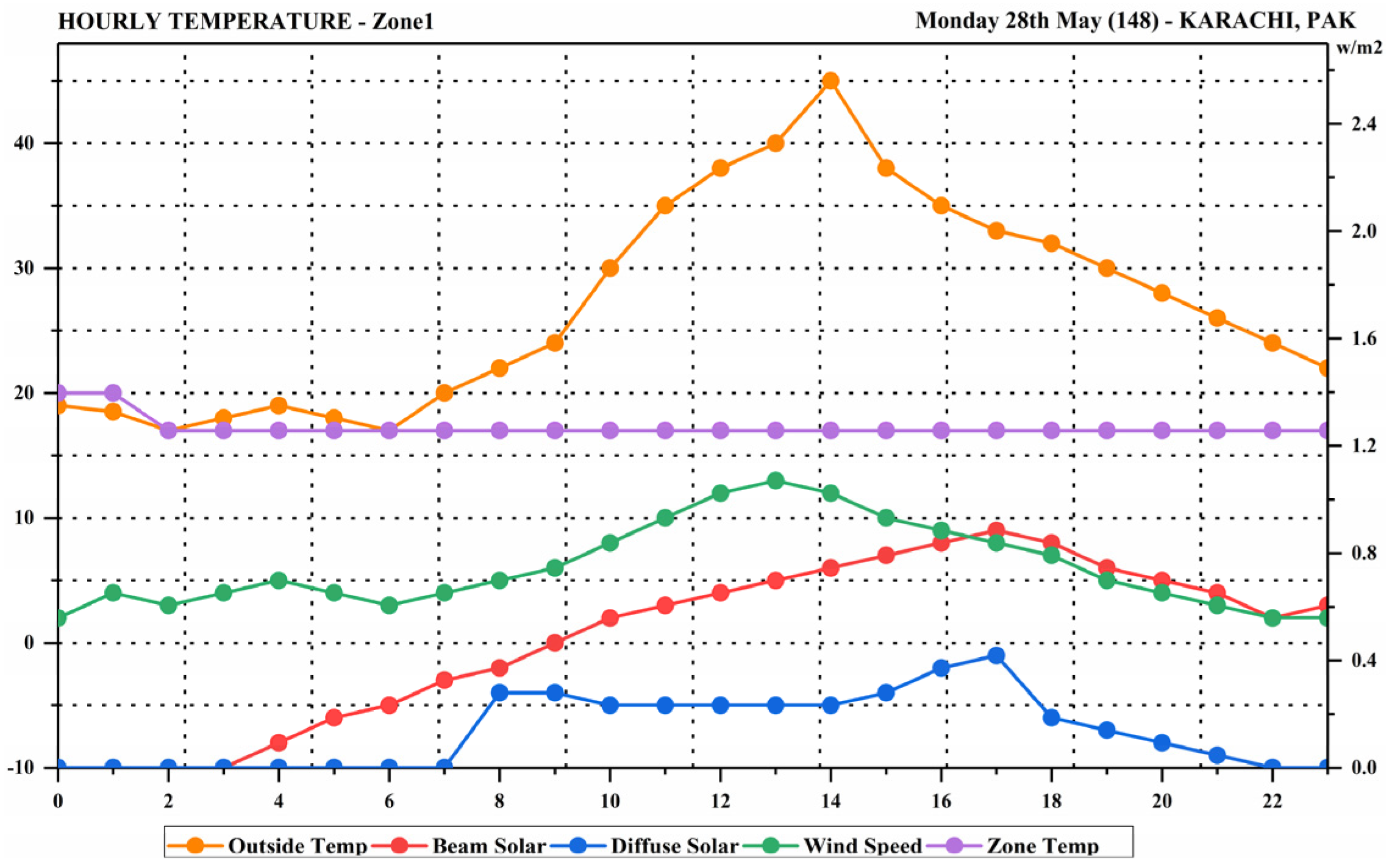
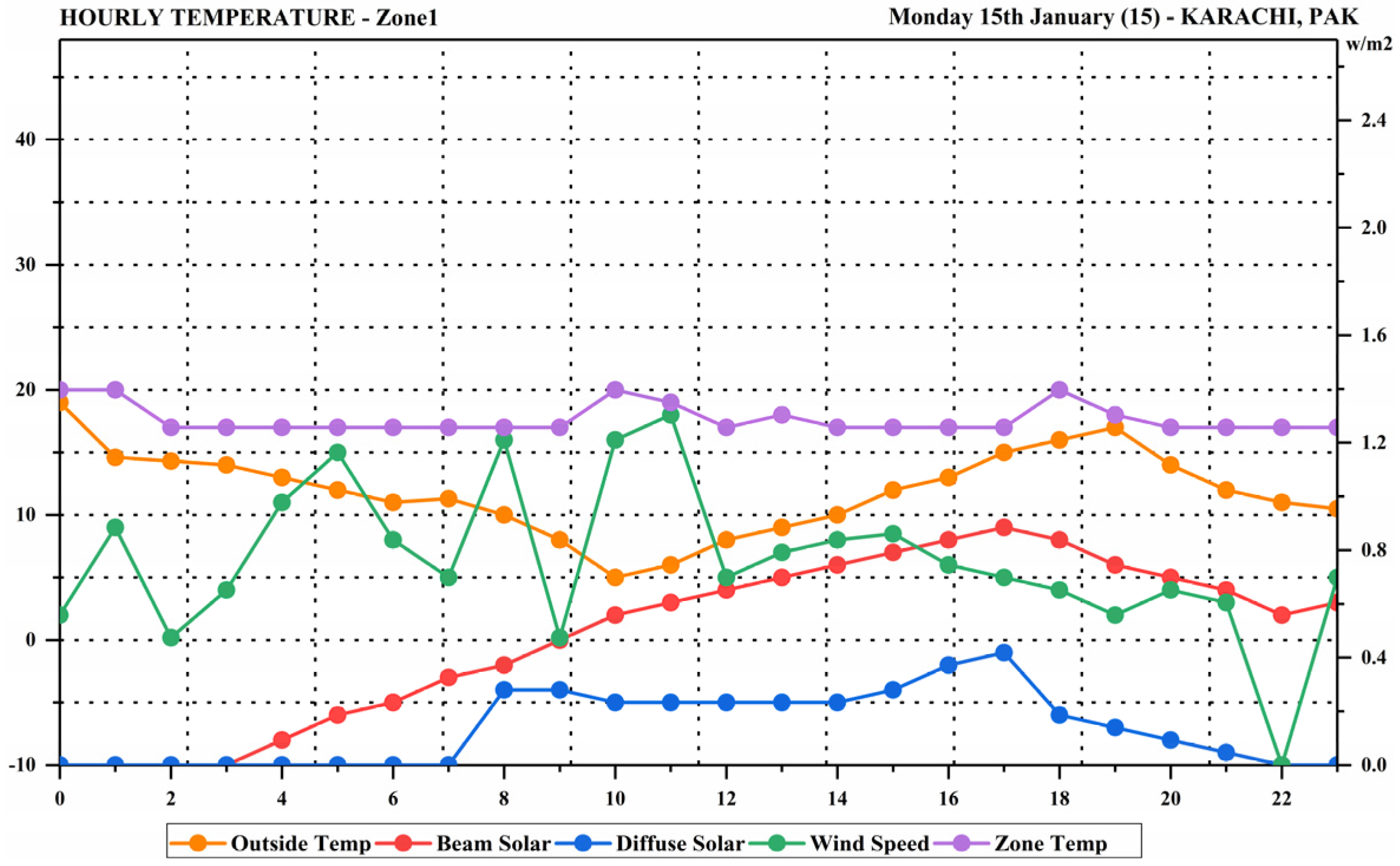

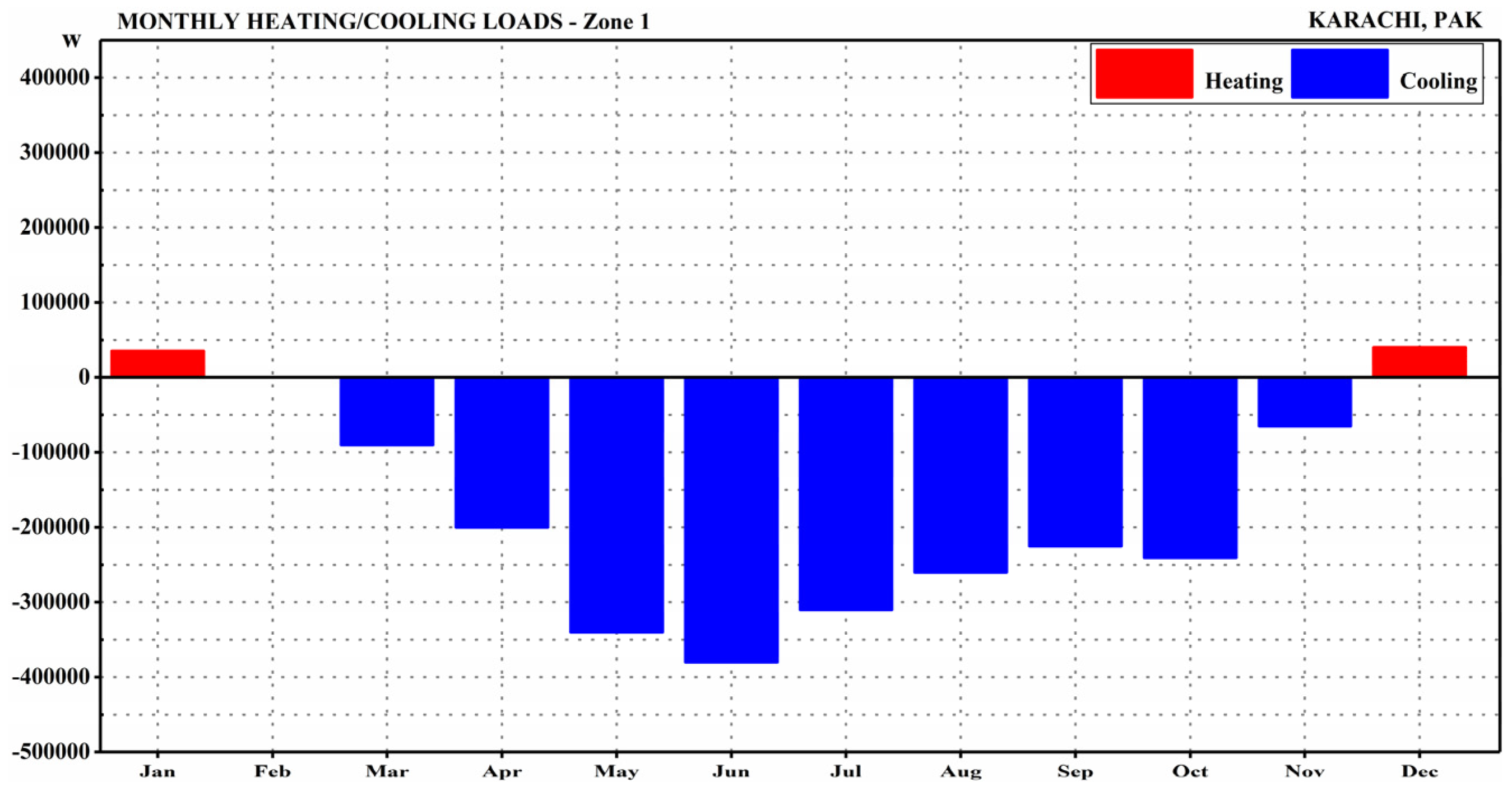

| S. No | Type | Characteristics |
|---|---|---|
| 1 | Wood | Sustainably sourced timber and engineered wood products like cross-laminated timber (CLT) are popular choices due to their renewable nature. |
| 2 | Bamboo | A rapidly renewable resource, bamboo is strong, lightweight, and can be used in various construction applications. |
| 3 | Recycled Steel | Using recycled steel reduces the demand for new steel production, which has a significant environmental impact. |
| 4 | Recycled Concrete | Incorporating recycled concrete aggregates helps divert waste from landfills and reduces the need for new concrete production. |
| 5 | Rammed Earth | A technique where natural raw materials like earth, chalk, lime, or gravel are compacted to form walls. |
| 6 | Straw Bales | Used for insulation and can be an excellent natural insulating material. |
| 7 | Recycled Glass and Recycled Plastic | Used in the production of glass countertops, tiles, and architectural elements. Some prefabricated materials incorporate recycled plastics, which helps reduce plastic waste. |
| 8 | Sustainable Insulation Materials | These can include materials like sheep’s wool, cotton, or recycled denim. |
| 9 | Green Roofs | Vegetative layers on the roof provide insulation, reduce storm water runoff, and improve air quality. |
| 10 | Solar Panels and Photovoltaic Cells | These are integrated into the structure to generate renewable energy. |
| 11 | Energy-Efficient Windows and Doors | These are designed to minimize heat loss and gain. |
| 12 | Rainwater Harvesting Systems | Collecting and reusing rainwater for non-potable uses. |
| S. No | Type | Detail | ||
|---|---|---|---|---|
| 1 | Project Location | District Kohat, Pakistan | ||
| 2 | Context | Residential, Sub-urban area | ||
| 3 | Climatic Zone | Arid zone (hot) Zone 4 | ||
| 4 | Building type | Residential | ||
| 5 | No of Users | 1 master bed room + 2 bed rooms having attached bath rooms, kitchen–dining + porch | ||
| 6 | Project Area | Site Area 8900 Sq-ft | Covered 2878 Sq-ft | Open 6022 Sq-ft |
| 7 | Techniques and methodology | Energy efficient, sustainable and passive environmental control system. | ||
| 8 | Building Materials: | Sedimentary stone, mortar (sand and cement), T-iron, and Chawka brickwork with clay used in the roof. | ||
| 9 | Client/User Requirement | The client, a civil engineer with over 20 years of experience in Doha, Qatar, prioritized sustainable and energy-efficient techniques. Inspired by villas utilizing passive means, he demanded a design reflecting local and indigenous styles. His vision included sustainable living, incorporating farming, livestock, and extensive landscaping within the house. | ||
| 10 | Other | The plot area is covered with an outside landscape, including for livestock (chickens and pigeons). Open areas include landscape features, use, and farming. | ||
| S. No | Type | Details |
|---|---|---|
| 1 | Accessibility | The site is connected from two sides and 22 feet wide. The road on the south and east sides of the site and the main 30-foot-wide road are connected on the eastern side. |
| 2 | Shape and Area of Site | Rectangular and plain. |
| 3 | Availability of Services | All the major utilities are available along the adjacent road to the site. Sewerage and water supply lines. Gas and electricity are available at adequate capacity. |
| 4 | Topography | The site is plain, having no contours. |
| 5 | Orientation | The north is at a 30-degree angle to the site. The sun’s path is east toward west through south. Wind direction: summer wind west to east, and winter wind north towards south. |
| 6 | Context | With reference to the context of the proposed area, there are residential buildings on three sides of the site, and one side is open. |
| S. No | Zone 1 | |
|---|---|---|
| 1 | Avg. Temperature | 31.2 °C (Ground 26.2 °C) |
| 2 | Total Surface Area | 69.079 m2 (351.9% flr area). |
| 3 | Total Exposed Area | 46.660 m2 (237.7% flr area). |
| 4 | Total South Window | 0.000 m2 (0.0% flr area). |
| 5 | Total Window Area | 4.181 m2 (21.3% flr area). |
| 6 | Total Conductance (AU) | 85 W/°K |
| 7 | Total Admittance (AY) | 364 W/°K |
| 8 | Response Factor | 3.95 |
| S. No | Hour | Inside | Outside | Temperature Difference |
|---|---|---|---|---|
| 1 | 0 | 26 | 28 | −2 |
| 2 | 1 | 26 | 27 | −1 |
| 3 | 2 | 26 | 27 | −1 |
| 4 | 3 | 26 | 27 | −1 |
| 5 | 4 | 26 | 26 | 0 |
| 6 | 5 | 26 | 26 | 0 |
| 7 | 6 | 26 | 27 | −1 |
| 8 | 7 | 26 | 28 | −2 |
| 9 | 8 | 26 | 30 | −4 |
| 10 | 9 | 26 | 32 | −6 |
| 11 | 10 | 26 | 36 | −10 |
| 12 | 11 | 26 | 37 | −11 |
| 13 | 12 | 26 | 44 | −18 |
| 14 | 13 | 26 | 39 | −13 |
| 15 | 14 | 26 | 40 | −14 |
| 16 | 15 | 26 | 39 | −13 |
| 17 | 16 | 26 | 38.5 | −12.5 |
| 18 | 17 | 26 | 36.7 | −10.7 |
| 19 | 18 | 26 | 35 | −9 |
| 20 | 19 | 26 | 31 | −5 |
| 21 | 20 | 26 | 31 | −5 |
| 22 | 21 | 26 | 30 | −4 |
| 23 | 22 | 26 | 30.5 | −4.5 |
| 24 | 23 | 26 | 29 | −3 |
| S. No | Zone 1 | |
|---|---|---|
| 1 | Avg. Temperature | 16.6 °C (Ground 26.2 °C) |
| 2 | Total Surface Area | 69.079 m2 (351.9% flr area). |
| 3 | Total Exposed Area | 46.660 m2 (237.7% flr area). |
| 4 | Total South Window | 0.000 m2 (0.0% flr area). |
| 5 | Total Window Area | 4.181 m2 (21.3% flr area). |
| 6 | Total Conductance (AU) | 85 W/°K |
| 7 | Total Admittance (AY) | 364 W/°K |
| 8 | Response Factor | 3.95 |
| S. No | Hour | Inside | Outside | Temperature Difference |
|---|---|---|---|---|
| 1 | 0 | 18 | 15 | 3 |
| 2 | 1 | 18 | 15 | 3 |
| 3 | 2 | 18 | 14 | 4 |
| 4 | 3 | 18 | 13 | 5 |
| 5 | 4 | 18 | 11.5 | 6.5 |
| 6 | 5 | 18 | 12 | 6 |
| 7 | 6 | 18 | 11 | 7 |
| 8 | 7 | 18 | 6.1 | 11.9 |
| 9 | 8 | 18 | 13 | 5 |
| 10 | 9 | 18 | 14 | 4 |
| 11 | 10 | 18 | 14.5 | 3.5 |
| 12 | 11 | 18 | 16 | 2 |
| 13 | 12 | 18 | 17 | 1 |
| 14 | 13 | 18 | 17.5 | 0.5 |
| 15 | 14 | 18 | 18 | 0 |
| 16 | 15 | 18 | 18 | 0 |
| 17 | 16 | 18 | 17.5 | 0.5 |
| 18 | 17 | 18 | 17 | 1 |
| 19 | 18 | 18 | 16 | 2 |
| 20 | 19 | 18 | 15 | 3 |
| 21 | 20 | 18 | 14 | 4 |
| 22 | 21 | 18 | 12 | 6 |
| 23 | 22 | 18 | 11 | 7 |
| 24 | 23 | 18 | 11 | 7 |
| S. No | Zone 1 | |
|---|---|---|
| 1 | Operation | Weekdays 00–24, Weekends 00–24 |
| 2 | Thermostat Settings | 18.0–26.0 °C |
| 3 | Max Heating | 666 W at 07:00 on 15 January |
| 4 | Max Cooling | 1293 W at 15:00 on 3 June |
| S. No | Hour | HVAC (Wh) | FABRIC (Wh) | SOLAR (Wh) | VENT (Wh) | INTERN (Wh) | ZONAL (Wh) |
|---|---|---|---|---|---|---|---|
| 1 | 0 | 325 | 161 | 0 | 65 | 98 | 0 |
| 2 | 1 | 269 | 140 | 0 | 31 | 98 | 0 |
| 3 | 2 | 262 | 134 | 0 | 30 | 98 | 0 |
| 4 | 3 | 242 | 115 | 0 | 29 | 98 | 0 |
| 5 | 4 | 176 | 78 | 0 | 0 | 98 | 0 |
| 6 | 5 | 143 | 45 | 0 | 0 | 98 | 0 |
| 7 | 6 | 188 | 59 | 0 | 31 | 98 | 0 |
| 8 | 7 | 247 | 83 | 0 | 65 | 98 | 0 |
| 9 | 8 | 343 | 111 | 0 | 134 | 98 | 0 |
| 10 | 9 | 450 | 156 | 0 | 196 | 98 | 0 |
| 11 | 10 | 674 | 262 | 0 | 314 | 98 | 0 |
| 12 | 11 | 776 | 310 | 0 | 368 | 98 | 0 |
| 13 | 12 | 1120 | 484 | 0 | 537 | 98 | 0 |
| 14 | 13 | 969 | 429 | 0 | 442 | 98 | 0 |
| 15 | 14 | 1112 | 493 | 0 | 521 | 98 | 0 |
| 16 | 15 | 1036 | 481 | 0 | 456 | 98 | 0 |
| 17 | 16 | 1076 | 569 | 0 | 409 | 98 | 0 |
| 18 | 17 | 916 | 464 | 0 | 354 | 98 | 0 |
| 19 | 18 | 844 | 445 | 0 | 301 | 98 | 0 |
| 20 | 19 | 616 | 355 | 0 | 163 | 98 | 0 |
| 21 | 20 | 598 | 350 | 0 | 149 | 98 | 0 |
| 22 | 21 | 560 | 333 | 0 | 128 | 98 | 0 |
| 23 | 22 | 537 | 324 | 0 | 115 | 98 | 0 |
| 24 | 23 | 474 | 289 | 0 | 87 | 98 | 0 |
| Total | - | 13,951 | 6670 | 0 | 4925 | 2356 | 0 |
Disclaimer/Publisher’s Note: The statements, opinions and data contained in all publications are solely those of the individual author(s) and contributor(s) and not of MDPI and/or the editor(s). MDPI and/or the editor(s) disclaim responsibility for any injury to people or property resulting from any ideas, methods, instructions or products referred to in the content. |
© 2024 by the authors. Licensee MDPI, Basel, Switzerland. This article is an open access article distributed under the terms and conditions of the Creative Commons Attribution (CC BY) license (https://creativecommons.org/licenses/by/4.0/).
Share and Cite
Ullah, H.; Zhang, H.; Ye, H.; Ali, I.; Cong, M. Research on Low-Carbon Design and Energy Efficiency by Harnessing Indigenous Resources through BIM-Ecotect Analysis in Hot Climates. Sustainability 2024, 16, 6057. https://doi.org/10.3390/su16146057
Ullah H, Zhang H, Ye H, Ali I, Cong M. Research on Low-Carbon Design and Energy Efficiency by Harnessing Indigenous Resources through BIM-Ecotect Analysis in Hot Climates. Sustainability. 2024; 16(14):6057. https://doi.org/10.3390/su16146057
Chicago/Turabian StyleUllah, Habib, Hong Zhang, Hongyu Ye, Ihsan Ali, and Meng Cong. 2024. "Research on Low-Carbon Design and Energy Efficiency by Harnessing Indigenous Resources through BIM-Ecotect Analysis in Hot Climates" Sustainability 16, no. 14: 6057. https://doi.org/10.3390/su16146057







